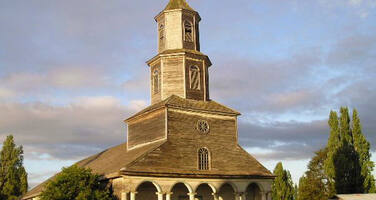Churches of Chiloé
Factors affecting the property in 2004*
- Storms
- Water (rain/water table)
Factors* affecting the property identified in previous reports
Lack of human or financial resources; Hurricanes
International Assistance: requests for the property until 2004
Total amount approved : 50,000 USD
| 2002 | Emergency assistance for the Churches of Chiloé (Approved) | 50,000 USD |
Missions to the property until 2004**
Conservation issues presented to the World Heritage Committee in 2004
The Secretariat received two progress reports from the Consejo de Monumentos Nacionales (National Monuments Council) of the Ministry of Education on the restoration activities on the Churches of Chiloé, including the latest information concerning an Inter-American Development Bank loan, on 14 April 2004.
The first report focused on the general activities plan for the period 2004-2006, while the second one summarized the restoration activities carried out from 2001 until 2003, including a budget breakdown. The churches of Castro and Dalcahue were restored in 2001, while in 2002 a feasibility study was carried out on the churches of Colo and Chonci (seriously damaged by heavy rains), for which the Chilean Government had allocated US$52,000. In that same year UNESCO provided financial assistance (US$50,000) in order to restore the Church of San Juan and to elaborate an emergency restoration plan for the complete site, while the World Monuments Fund allocated US$350,000 for the restoration of Tenaún. Thanks to a loan of US$ three millions provided through the Inter-American Development Bank planning is underway to restore all 16 churches, being for 2004: Tenaún, Vilupulli, Quinchao, Aldachildo, Ichuac; for 2005: Nercón, Rilán, Chelín and for 2006: Caguach, Achao, Detif, Dalcahue.
Among the activities foreseen in the action plan particular emphasis is given to the proyectos transversals (cross-cutting projects), among which capacity building programmes like seminars for training carpenters, for the site guides, and international symposia on restoration techniques. The report underlined that all the activities are implemented via the Fundación Amigos de las Iglesias de Chiloé (Friends of the Chiloé Churches Foundation), which is a non-profit organisation.
Summary of the interventions
Decisions adopted by the Committee in 2004
28 COM 15B.111
The World Heritage Committee, 1. Taking note of the progress reports transmitted by the State Party (Decision 27 COM 7B.88), 2. Commends the authorities for their comprehensive programme of restoration and training activities, on-going as well as foreseen, and for having generated significant additional funding to the Emergency Assistance, which was provided under the World Heritage Fund; 3. Thanks the World Monuments Fund and the Fundación Amigos de las Iglesias de Chiloé for their contribution to the implementation of the restoration activities.
Draft Decision: 28 COM 15B.111
The World Heritage Committee,
1. Taking note of the progress reports transmitted by the State Party,
2. Commends the authorities for their comprehensive programme of restoration and training activities, on-going as well as foreseen, and for having generated significant additional funding to the Emergency Assistance, which was provided under the World Heritage Fund;
3. Thanks the World Monuments Fund and the Fundación Amigos de las Iglesias de Chiloé for their contribution to the implementation of the restoration activities.
* :
The threats indicated are listed in alphabetical order; their order does not constitute a classification according to the importance of their impact on the property.
Furthermore, they are presented irrespective of the type of threat faced by the property, i.e. with specific and proven imminent danger (“ascertained danger”) or with threats which could have deleterious effects on the property’s Outstanding Universal Value (“potential danger”).
** : All mission reports are not always available electronically.


